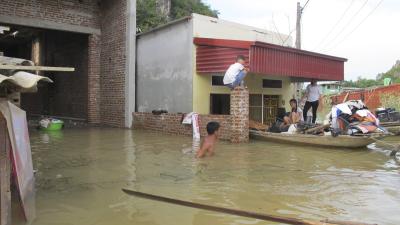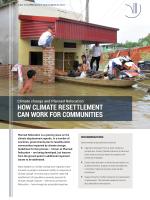How climate resettlement can work for communities

■ Approach relocation from a wider resilience perspective. Employ flexible solutions to land and other resource access based on people’s own livelihood strategies.
■ Ensure that relocation is driven by real needs, not political interests. Support checks and balances in decision making to prevent unwarranted relocations.
■ Support fora for conflict resolution and expression of grievances. This includes statutory fora but also alternative mechanisms.
Planned Relocation is a growing issue on the climate displacement agenda. In a number of countries, governments plan to resettle entire communities impacted by climate change. Guidelines for this process – known as Planned Relocation – are being developed, but lessons from the ground point to additional important issues to be addressed.
Most debates on climate change and migration have focused on people’s individual mobility in response to climate change. In recent years, however, state-led resettlement of populations severely exposed to climate change impacts – referred to as Planned Relocation – has emerged as a possible response.Yet little is known about how such interventions play out on the ground in the context of development. This brief reviews key findings and policy implications from research on Planned Relocation in Vietnam and Zambia.
Internationally, Planned Relocation is recognized as an option in the Cancun Adaptation Framework under the United Nations Framework Convention for Climate Change (UNFCCC), the Sendai Framework for Disaster Risk Reduction, and in the work of the Warsaw International Mechanism for Loss and Damage. In extension of this, various guidance notes and a toolbox have been developed in collaboration with the UN Refugee Agency (UNHCR). These guidelines all emphasize a core principle, namely that Planned Relocation should be seen as the last possible option. They further highlight the importance of:
- establishing legal frameworks for Planned Relocation
- understanding the needs and impacts on affected populations
- ensuring the participation of affected populations
- addressing land issues
- undertaking monitoring and evaluation and ensuring accountability
While frameworks and guidelines are emerging at the international level, some governments are already relocating affected communities. In Zambia, we studied resettlement of small-scale farmers and agro-pastoralists in response to flooding and changing rainfall patterns. In Vietnam, we examined two cases of planned relocation. In one, Sampan boat dwellers were moved onto dry land as a response to intensified storms. In another, coastal villagers were moved in response to extreme coastal erosion linked to climate change. Our research substantiates the guiding principles referred to above, but also highlights three issues that need more attention.
Recommendation 1: Approach relocation from a wider resilience perspective
For planners and other practitioners, relocation is often perceived as a response to a particular climatic hazard such as intensified floods and droughts, or rising sea levels. From this perspective, relocation may seem entirely rational. However, people’s ability to cope with climate hazards is shaped by a broader range of issues that relocation does not necessarily address. This has implications for the outcomes of Planned Relocation:
People’s ability to cope with climate hazards is shaped by a broader range of issues that relocation does not necessarily address
Firstly, relocation may overlook key opportunities to foster broader resilience. For planners in Zambia, relocation entailed a permanent move and the adoption of new livelihoods. However, for many households the solution to floods and drought was not to move, but to expand their access rights to land, water and other resources – and thereby improve both their ability to cope with drought and floods, and their ability to sustain and expand existing livelihood strategies. These different perspectives led to conflict between planners and households.
Secondly, even when relocation seems the best option, it may leave some people worse off. In Zambia, relocation reduced access to water resources for some households, hampering their existing coping and livelihood strategies. In Vietnam, relocation incurred unexpected costs for e.g. home construction and utilities, straining households’ financial resources. In both countries, this left some households worse off than before.
Our findings emphasize that approaches to Planned Relocation should focus on flexible and resilience-oriented solutions driven by the livelihood needs and strategies of the communities in question. This includes considering whether permanent relocation is actually necessary, or whether improving access to land and water for temporary coping and longer-term adaptation is better. When relocation is found to be necessary, it should be approached as an expansion of existing livelihood strategies and mobility patterns, not an end to them.
Our findings emphasize that approaches to Planned Relocation should focus on flexible and resilience-oriented solutions driven by the livelihood needs and strategies of the communities in question.
Recommendation 2: Ensure that relocation is driven by real needs, not political interests
There has been much attention to the responsibility of governments to help people relocate. This is important, but there’s a need for more attention to the fact that governments may seek to promote relocation even when it is not the best option. In Zambia, the central government has larger strategic motives for promoting relocation, including territorial control. In Vietnam, relocation has afforded more control of rural communities to sub-national government institutions. This includes the settlement of minority and semi-nomadic peoples, a long-standing political goal in Vietnam. Such vested interests can mean that analysis of the need for relocation is biased, and that relocation is presented to communities as the only possible solution, even when alternatives exist.
To address this, there is a need to provide better checks and balances in the analysis and decision-making processes around Planned Relocation. This includes ensuring that alternatives to relocation are not only thoroughly analysed but also made transparent and subject to critical public scrutiny. Local, national and international civil society organisations should take on a greater watchdog role in this respect. Most importantly, relocation processes require more than “participation”. They should to a greater degree be driven by communities themselves and facilitated by institutional actors close to the ground, e.g. local governments, customary institutions, etc. at both points of origin and points of relocation.
Recommendation 3: Support fora for conflict resolution and expression of grievances
Relocation involves land and water rights, livelihoods and identity. It is deeply political and even with the above measures, conflicts can be inevitable. This is particularly true when relocation schemes become arenas for broader conflicts over land access and control, as has happened in Zambia.
Relocation must as far as possible be anchored in national legal frameworks that delineate rights to land and other resources, but our findings suggest that this is not enough in itself. Firstly, accessing statutory justice mechanisms can be difficult for the politically marginalized who are often the most exposed to climate hazards, as is the case in both Vietnam and Zambia. Secondly, formal input and mediation mechanisms may be lacking or purely pro forma in top-down governance contexts. In Vietnam, relocation policies can be mandatory, with little or no input or feedback gathered from those affected. Thirdly, in some countries statutory legal frameworks are only one among several ways whereby access to land and water is mediated and contested (others include customary authorities and civil society platforms). If Planned Relocation ignores this, conflicts may develop - as has been the case in Zambia.
Relocation interventions can therefore not rely solely on existing statutory legal frameworks. Support to locally anchored and easily accessible fora for expressing grievances and resolving conflicts is key. Different approaches will be needed from country to country, depending on the legal and political context. In settings such as Vietnam, formalizing input and critique at various stages of relocation will likely help strengthen outcomes. In settings such as Zambia, it may include involving customary justice and mediation mechanisms. Although duplication of existing fora and frameworks should be avoided as far as possible, there may be a need to establish particular intervention-specific mechanisms in some cases, given the gravity of Planned Relocation interventions.
DIIS Experts



